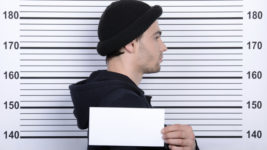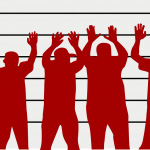The Rules Relating to Visual Identification Evidence in NSW

It was him! I’m 100% certain!
An identification by a person at the scene of an alleged crime can be powerful evidence before a jury.
After all, why would anyone identify a person they weren’t certain was responsible for a crime? They were present and such a serious, potentially life-altering incident must have left an indelible print on their memory, right?
But the fact of the matter is, visual identification evidence has proven time and again to be unreliable, with many honest and well-meaning but mistaken eye-witnesses fingering the wrong person – leading to wrongful convictions and the grave injustice of those who did not commit the crime spending years behind bars, before other evidence – such as DNA evidence – proves they were innocent all along.
The scope for mistaking a person’s identity is particularly broad when a person from one racial background identifies a person from another, and many other factors can also come into play including stress, the circumstances of the incident and the way in which our memories work, malleable and susceptible to influence rather than a record of what actually occurred.
Due to the potentially unfairly prejudicial nature of identification evidence, rules have developed to protect against the potentially dire effects of it being given too much weight in court.
Here’s an outline of the rules that apply in New South Wales.
What is visual identification evidence?
The Evidence Act 1995 defines ‘identification evidence’ as an assertion by a person to the effect that a defendant was, or resembles (visually, aurally or otherwise) a person who was, present at or near a place where:
- the offence for which the defendant is being prosecuted was committed; or
- an act connected to that offence was done;
- a report (whether oral or in writing) of such an assertion.
This assertion must relate to about the time at which the offence was committed or the act was done, being an assertion that is based wholly or partly on what the person making the assertion saw, heard or otherwise perceived at that place and time.
Identification evidence can come in the form of:
- Evidence of recognition, eg. “that is the man I saw stabbing the victim”
- Evidence of resemblance, eg. “the man I saw stabbing the victim had red hair and was a stocky build similar to the man I see now”.
‘Visual identification evidence’ is a sub-type of identification evidence, defined under section 114 of the Evidence Act 1995 as:
identification evidence relating to an identification based wholly or partly on what a person saw but does not include picture identification evidence.
Under the Act, ‘visual identification evidence’ is treated separately from ‘picture identification evidence’. Picture identification evidence is defined under section 115 of the Act as:
identification made wholly or partly by the person who made the identification examining pictures kept for the use of police officers.
The reliability of eye-witness identification depends on a lot of factors including how much time has elapsed after the event, the potential for contamination of memories, how well the person knew the person identified and the environment at the time of witnessing the event.
Because of this, identification evidence based around eye-witness accounts is treated cautiously by the courts.
The admissibility of visual identification evidence
Under section 114 of the Evidence Act 1995, visual identification evidence adduced by a prosecutor is generally not admissible unless:
- an identification parade that included the defendant was held before the identification was made, or
- it would not have been reasonable to have held such a parade, or
- the defendant refused to take part in such a parade.
An ‘identification parade’ is where the police put a suspect in a line-up of people. They then ask a witness to look at the line-up to see if they can pick the suspect out as the person who committed the offence. Police must collect somewhere between eight and twenty people who look similar to the suspect. This should include age, height and appearance but the lineup may not include police officers.
The Australian Law Reform Commission describes identification parades as the most reliable form of visual identification evidence. Alternatives to an identification parade, include tactics such as the witness observing the suspect in isolation and making a positive visual identification – an approach which carries a real risk of bias.
Matters that will be taken into account by the court in determining whether it was reasonable to hold an identification parade, include:
- The kind of offence, and the gravity of the offence, concerned, and
- The importance of the evidence, and
- The practicality of holding an identification parade having regard, among other things–
- If the defendant failed to cooperate in the conduct of the parade–to the manner and extent of, and the reason (if any) for, the failure, and
- Whether the identification was made at or about the time of the commission of the offence, and
- The appropriateness of holding an identification parade having regard, among other things, to the relationship (if any) between the defendant and the person who made the identification.
It is presumed that it would not have been reasonable to have held an identification parade if it would have been unfair to the defendant for such a parade to have been held. This includes if their lawyer was unable to be present.
Whether via an identification parade or other means, section 114(2) of the Act also makes it explicit that visual identification evidence will only be admissible if identification was made without the person who made it being intentionally influenced to identify the defendant.
What are the rules for admitting picture identification evidence?
Picture identification evidence is viewed as less reliable than visual identification evidence. Section 115 of the Act makes clear that picture identification evidence will not be admissible if:
- The pictures examined suggest that they are pictures of persons in police custody; or
- When the pictures were examined, the defendant was in the custody and the picture used was taken before the defendant was taken into custody (unless the defendant’s appearance has changed dramatically).
- The defendant was in custody and an identification parade was capable of being undertaken.
Jury cautions about identification evidence
Section 116 of the Evidence Act 1995 notes that if identification evidence is to be admitted the judge is to inform the jury:
- that there is a special need for caution before accepting identification evidence, and
- of the reasons for that need for caution, both generally and in the circumstances of the case.
Whilst there are no prescriptions on how this caution should be made, the NSW Criminal Trial Courts Bench Book suggests the following wording regarding the need for caution for visual forms of identification evidence:
Evidence that [the accused] has been identified by a witness must be approached by you with special caution before you accept it as reliable. These directions relate only to the reliability of the identification evidence given, not to the honesty of the witness[es]. A witness may be honest but that does not necessarily mean that the witness will give reliable evidence. Because the witness who gives evidence of identification honestly and sincerely believes that [his/her] evidence is correct, that evidence will usually be quite impressive, even persuasive. So here, even if you thought [name of witness] was entirely honest in the evidence that [he/she] gave, you must still approach the task of assessing the reliability of [his/her] evidence with special caution.
So, special caution is necessary before accepting identification evidence because of the possibility that a witness may be mistaken in their identification of a person accused of a crime. The experience of the criminal courts over the years, both here in Australia and overseas, has demonstrated that identification evidence may turn out to be unreliable. There have been some notorious cases over the years in which evidence of identification has been demonstrated to be wrong after innocent people have been convicted.
You must carefully consider the circumstances in which [name of witness] made [his/her] observation of the person. The circumstances in which the witness made [his/her] observation of the person can affect the reliability of identification evidence.
More comprehensive wording is provided if there are particular circumstances that give rise to a need for caution, such as:
There are a number of matters that have been specifically raised in this case that require your consideration.
[The trial judge should identify for the jury the particular matters in the case and make brief reference to the arguments in relation to each of them. The following matters are given by way of example and would need to be adapted to the circumstances of the individual case. In most cases the jury would be assisted by the judge providing the answer to the question posed.]
- Was the person identified a stranger to [name of witness]? It is obviously harder to identify strangers than it is to identify people who are well known to us. [recite evidence]
- What opportunity did [name of witness] have to make [his/her] observation of the person? [Name of witness] said the period of observation [he/she] had was … [recite evidence].
- Did the witness focus [his/her] attention on the person or was it just a casual sighting that did not have any significance for the witness at the time? [recite evidence]
- In what light was it made? You have heard evidence from [name of witness] about the light at the time of the alleged offence [recite evidence — for example, poor/bright, etc].
- Was there anything about the person observed which would have impressed itself upon the witness? In other words, was there anything distinctive about the person? [recite evidence — for example, tattoo, albino, etc]
- Was there any special reason for remembering the person observed?
- Was the witness under any stress or pressure at the time? For example, if a person is woken up suddenly or hit in the face. If [name of witness] is under any stress or pressure at the time, how do you think that might have affected [his/her] ability to accurately observe the person and store the image of the person’s appearance in [his/her] memory?
- Does [name of witness] come from the same racial background as the person identified? That is also something you can bear in mind. It may be more difficult for a member of one race to identify an individual of another racial group. [recite evidence]
- When was [name of witness] first asked for a description of the person and how fresh would [his/her] memory have been at that time?
- How did the description given by [name of witness] compare with the appearance of [the accused]?
- How long was it between the sighting of the person and the giving of the description to the time that [name of witness] identified [the accused]?
You must give consideration to each of those matters. Any one of those circumstances may possibly lead to error.
Going to court for a criminal matter?
If you are going to court over a criminal case, call Sydney Criminal Lawyers anytime on 9261 8881 to arrange a free first conference during which one of our experienced criminal defence lawyers will advise you of your options and the best way forward, and fight for the optimal outcome.






